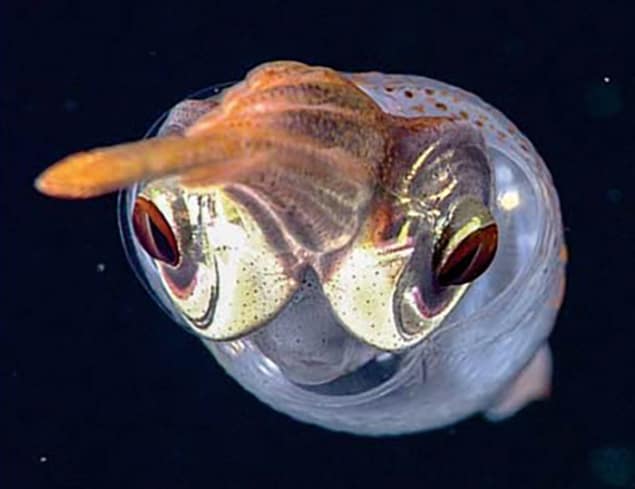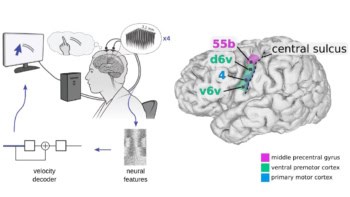
The eyes of squid and fish are miracles of evolution, producing bright, sharp images with limited light. How they do this, however, has been a mystery. But now researchers in the US have analysed the lenses in the eyes of a common squid species and found that proteins in different cells gel at different concentrations, giving the eye a refractive-index gradient that removes aberrations. The research could help to produce self-assembling nanoparticles.
A perfect lens should focus all parallel incident wavefronts at a single point. In spherical lenses, wavefronts strike the edge of the lens at a much steeper angle that those striking nearer the centre. They are therefore refracted more and brought to a closer focus – an effect called spherical aberration. The eyes of humans and some other land-dwelling animals have evolved non-spherical lenses to remove these aberrations. “The trade-off there is that our eyes aren’t as sensitive,” explains biophysicist Alison Sweeney of Penn State University in Philadelphia: “But given that we’re living on land where there’s lots of sunlight available – that’s a good trade-off.” In the dimmer conditions in the oceans, however, capturing every possible photon becomes crucial.
In 1854, James Clerk Maxwell showed that spherical aberrations could be eliminated by creating a lens with a variable refractive index that decreased from the centre towards the edge, so that wavefronts passing closer to the middle of the lens would experience a higher refractive index. Subsequently, biologists discovered that the eyes of fish and cephalopods (including squid and octopuses) had lenses exactly like this, but how they were formed was unclear.
Protein gradient
The refractive index of an eye lens depends principally on the protein concentration. Maintaining a refractive-index gradient, therefore, entails maintaining a concentration gradient without the proteins changing concentration randomly or sticking together into clumps, both of which could scatter light and turn the lens opaque.
Sweeney and colleagues dissected lenses from the eyes of the longfin inshore squid into four concentric layers. They confirmed that the refractive index of the layers increased from around 1.34 in the outermost layer to nearly 1.6 in the centre – consistent with Maxwell’s ideal spherical lens. They calculated from this that the outermost layer of the lens was a water-rich gel containing only 4% protein, whereas the innermost layer was a dense network of proteins with no free water.
The team isolated messenger RNA – the molecule a cell uses to trigger the building of particular proteins – to characterize the protein mixture in each lens section. Squid-lens proteins have “a pair of arms that flexibly and floppily stick off the protein into space”, says Sweeney. The researchers concluded over 40 different proteins were present. “The mixture of proteins found at every position in the lens seems complex,” says Sweeney. However, the length of the arms tended to increase towards the outside of the lens. The team concluded that the arms, whose function has previously remained unexplained, were used to link the molecules together.
Arms linked
The team used multiple independent analytical techniques to estimate that, at the edge of the lens, each protein molecule was bonded to only about two others, forming long protein chains with occasional cross-links. In the centre, however, each protein was bonded to nearly six others, forming a dense network. The team suggests that the long arms of the outermost molecules form links at very low concentrations, allowing the solution to gelate at a very low density. The short-armed molecules in the centre, however, have to pack more densely to form a gel. The researchers hypothesize that each cell stops protein synthesis when the proteins gelate, thereby allowing it to achieve the appropriate density and refractive index for its position.
Sweeney is sceptical, however, about direct optical applications of the discovery: “I think we probably have better optics than this,” she says. She thinks, however, that nature may teach engineers more general lessons about how to assemble nanoparticles. “I don’t know that anybody can make a centimetre-scale hunk of material out of nanoparticles where all the nanoparticles are well ordered, but that’s exactly what a squid lens does,” says Sweeney. “What can we learn from these genetically encoded linkers that allows a squid lens to make a bulk, ordered material out of [nanoscale proteins]?”
“How squid and fishes can achieve such a perfect lens is a research question which has been around for quite some time, and this is the first explanation of how it could work in principle,” says structural biologist Tobias Madl of the Medical University of Graz in Austria. He says the large number of proteins present need confirmation, however. “It could be that not every RNA is transcribed into a protein.”
Natural selection
Condensed -matter physicist Francesco Sciortino of Sapienza University of Rome calls the work “outstanding”. “In Rome we have developed new concepts to explain the ability of some systems to form stable gels. What Allison and co-workers have been able to show is that natural selection had already been able to exploit the particular physics, which we have only recently understood.”
The research is described in Science.



